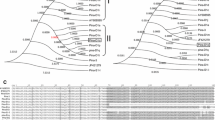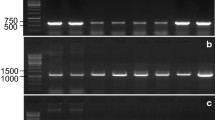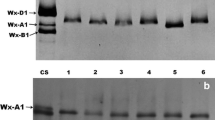Abstract
Fifty-six sequences encoding the pina protein were characterized from three species or subspecies of einkorn wheat. These sequences contained 1,595 nucleotides, including 1,270 conserved sites, 21 single nucleotide polymorphisms (SNPs), and 16 indels. The average frequency of SNPs and indels was one out of 76.1 and 99.9 bases, respectively. Five SNPs and no indels were found in the translated sequences. Fourteen haplotypes were defined, and the accessions in each haplotype ranged from 1 to 18. There were nine haplotypes in Triticum monococcum ssp. aegilopoides, eight in T. monococcum ssp. monococcum, and two in T. urartu. Phylogenetic analysis showed that pina genes from different species or subspecies could be clearly differentiated based on the open reading frame. Genes from T. urartu grouped together, whereas genes from T. monococcum ssp. aegilopoides and T. monococcum ssp. monococcum were shared by three and two clusters, respectively. Both the haplotype and phylogenetic analyses indicated that T. monococcum ssp. aegilopoides was more diverse. These results would contribute to the understanding of functional aspects and efficient utilization of pina genes.


Similar content being viewed by others
References
Beecher B, Smidansky ED, See D, Blake TK, Giroux MJ (2001) Mapping and sequence analysis of barley hordoindolines. Theor Appl Genet 102:833–840
Bettge AD, Morris CF, Greenblatt GA (1995) Assessing genotypic softness in single wheat kernels using starch granule-associated friabilin as a biochemical marker. Euphytica 86:65–72
Blochet JE, Chevalier C, Forest E, Pebay-Peyroula E, Gautier MF, Joudrier P, Pézolet M, Marion D (1993) Complete amino-acid sequence of puroindoline, a new basic and cystine-rich protein with a unique tryptophan-rich domain, isolated from wheat endosperm by Triton X-114 phase partitioning. FEBS Lett 329:336–340
Chantret N, Cenci A, Sabot F, Amderson O, Dubcovsky J (2004) Sequencing of the Triticum monococcum Hardness locus reveals good microlinearity with rice. Mol Genet Genomics 271:377–386
Chen F, He ZH, Xia XC, Xia LQ, Zhang XY, Lillemo M, Morris CF (2006) Molecular and biochemical characterization of puroindoline a and b alleles in Chinese landraces and historical cultivars. Theor Appl Genet 112:400–409
Chen M, Wilkinson M, Tosi P, He G, Shewry P (2005) Novel puroindoline and grain softness protein alleles in Aegilops species with the C, D, S, M and U genomes. Theor Appl Genet 111:1159–1166
Darlington HF, Rouster J, Hoffimann L, Halford NG, Shewry PR, Simpson D (2001) Identification and molecular characterisation of hordoindolines from barley grain. Plant Mol Biol 47:785–794
Filatenko A, Hammer K (1997) New descriptions of hulled wheats on the infraspecific level. Genet Resour Crop Evol 44:285–288
Garg K, Green P, Nickerson DA (1999) Identification of candidate coding region single nucleotide polymorphisms in 165 human genes using assembled expressed sequence tags. Genome Res 9:1087–1092
Gautier MF, Aleman ME, Guirao A, Marion D, Joudrier P (1994) Triticum aestivum puroindolines, two basic cystine-rich seed proteins: cDNA sequence analysis and developmental gene expression. Plant Mol Biol 25:43–57
Gautier MF, Cosson P, Guirao A, Alary R, Joudrier P (2000) Puroindoline genes are highly conserved in diploid ancestor wheats and related species but absent in tetraploid Triticum species. Plant Sci 2000(153):81–91
Gedye KR, Morris CF, Bettge AD (2004) Determination and evaluation of the sequence and textural effects of the puroindoline a and puroindoline b genes in a population of synthetic hexaploid wheat. Theor Appl Genet 109:1597–1603
Giroux MJ, Morris CF (1997) A glycine to serine change in puroindoline b is associated with wheat grain hardness and low levels of starch-surface friabilin. Theor Appl Genet 95:857–864
Greenwell P, Schofield JD (1986) A starch granule protein associated with endosperm softness in wheat. Cereal Chem 63:379–380
Kruglyak L (1997) The use of a genetic map of biallelic markers in linkage studies. Nat Genet 17:21–24
Kumar S, Tamura K, Nei M (2004) Mega3: integrated software for molecular evolutionary genetics analysis and sequence alignment. Brief Bioinform 5:150–163
Law CN, Young CF, Brown JWS, Snape JW, Worland AJ (1978) The study of grain protein control in wheat using whole chromosome substitution lines. In: Seed protein improvement by nuclear techniques. International Atomic Energy Agency, Vienna, Austria, pp 483–502
Lillemo M, Morris CF (2000) A leucine to proline mutation in puroindoline b is frequently present in hard wheats from Northern Europe. Theor Appl Genet 100:1100–1107
Lillemo M, Simeone MC, Morris CF (2002) Analysis of puroindoline a and b sequences from Triticum aestivum cv ‘Penawara’ and related diploid taxa. Euphytica 126:321–331
Massa AN, Morris CF (2004) Relationship between sequence polymorphism of GSP-1 and puroindoline in Triticum aestivum and Aegilops tauschii. In: Lafiandra D, Masci S, D’Ovidio R (eds) The gluten proteins. RSC, Cambridge, pp 461–464
Massa AN, Morris CF, Gill BS (2004) Sequence diversity of Puroindoline-a, Puroindoline-b and the grain softness protein genes in Aegilops tauschii Coss. Crop Sci 44:1808–1816
Mattern PJ, Morris R, Schmidt JW, Johnson VA (1973) Location of genes for kernel properties in the wheat variety “Cheyenne” using chromosome substitution lines. In: Sears ER, Sears LMS (eds) Proceedings of the 4th international wheat genetics symposium. University of Missouri, Columbia, MO, pp 703–707
Morris CF (2002) Puroindolines: the molecular genetic basis of wheat grain hardness. Plant Mol Biol 48:633–647
Morris CF, Rose SP (1996) Wheat. In: Henry RJ, Kettlewell PS (eds) Cereal grain quality. Chapman and Hall, New York, pp 3–54
Morris CF, Greenblatt GA, Bettge AD, Malkawi HI (1994) Isolation and characterization of multiple forms of friabilin. Cereal Sci 21:167–174
Multani DS, Dhaliwal HS, Sharma SK, Gill KS (1989) Inheritance of isoproturon tolerance in durum wheat transferred from Triticum monococcum. Plant Breed 102:166–168
Nesbitt M, Samuel D (1996) From staple crop to extinction? The archaeology and history of the hulled wheats. In: Padulosi S, Hammer K, Heller J (eds) Hulled wheats. Proceedings of the first international workshop on hulled wheats. Castelvecchio Pascoli, Tuscany, Italy, pp 41–100
Oda S, Schofield JD (1997) Characterization of friabilin polypeptides. Cereal Sci 26:29–36
Pogna N, Gazza L, Corona V, Zanier R, Niglio AEM, Palumbo M, Boggini G (2002) Puroindolines and kernel hardness in wheat species. In: Ng PKW, Wrigley CW (eds) Wheat quality elucidation: the Bushuk legacy. AACC, St Paul, pp 155–169
Saitou N, Nei M (1987) The neighbor-joining method: a new method for reconstructing phylogenetic trees. Mol Biol Evol 4:406–425
Sharma HC, Waines JG, Foster KW (1981) Variability in primitive and wild wheats for useful genetic characters. Crop Sci 21:555–559
Sharp PJ, Chao S, Desai S, Gale MD (1989) The isolation, characterization and application in Triticeae of a set of wheat RFLP probes identifying each homologous chromosome arm. Theor Appl Genet 78:342–348
Tanchak MA, Schernthaner JP, Giband M, Altosaar I (1998) Tryptophanins: isolation and molecular characterization of oat cDNA clones encoding proteins structurally related to puroindoline and wheat grain softness proteins. Plant Sci 137:173–184
Thompson JD, Higgins DG, Gibson TJ (1994) CLUSTAL W: improving the sensitivity of progressive multiple sequence alignment through sequence weighting, positions-specific gap penalties and weight matrix choice. Nucleic Acids Res 22:4673–4680
Tranquili G, Lijavetzky D, Muzzi G, Dubcovsky J (1999) Genetic and physical characterisation of grain texture-related loci in diploid wheat. Mol Gen Genet 262:846–850
Turnbull KM, Gaborit T, Marion D, Rahman S (2000) Variation in puroindoline polypeptides in Australian wheat cultivars in relation to grain hardness. Plant Physiol 27:153–158
Acknowledgments
All the PI marked materials were kindly supplied by National Small Grains Collection, U.S. Department of Agriculture-Agricultural Research Service (USDA-ARS), USA. This study was supported by the National High Technology Research and Development Program of China (863 program 2006AA10Z179 and 2006AA10Z1F8), the Key Technologies R&D Program of China (2006BAD01A02-23 and 2006BAD13B02), and the FANEDD project (200357 and 200458) from the Ministry of Education, China. Dr. Y.-M. Wei was supported by the Program for New Century Excellent Talents in Universities of China (NCET-05-0814). Prof. Y.-L. Zheng was supported by the Program for Changjiang Scholars and Innovative Research Teams in Universities of China (IRT0453).
Author information
Authors and Affiliations
Corresponding author
Additional information
Qing Chen and Peng-Fei Qi contributed equally to this article.
Rights and permissions
About this article
Cite this article
Chen, Q., Qi, PF., Wei, YM. et al. Molecular Characterization of the pina Gene in Einkorn Wheat. Biochem Genet 47, 384–396 (2009). https://doi.org/10.1007/s10528-009-9239-1
Received:
Accepted:
Published:
Issue Date:
DOI: https://doi.org/10.1007/s10528-009-9239-1




